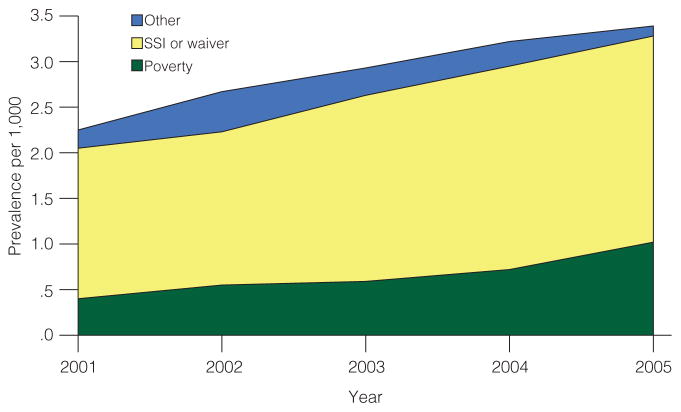Over the past two decades, the prevalence of autism spectrum disorders (ASDs) has increased dramatically among U.S. children and adolescents. Though attention has been paid to improving access to care for youths with ASDs who are covered by commercial insurance, Medicaid’s role in delivering ASD services to children has expanded with much less fanfare.
Here we report data on the number of youths aged three to 17 who had a Medicaid-reimbursed service related to ASD between 2001 and 2005. For this analysis of claims data, youths who had an inpatient visit or two or more outpatient visits with a primary ASD diagnosis were deemed to have ASD. Previous studies have identified quality issues with Medicaid managed care claims data; therefore, we limited the prevalence calculation to states with managed care penetration rates of 34% or less (18–20 states, depending on the year).
As shown in Figure 1, from 2001 to 2005, the treated prevalence of ASD in the Medicaid system for these states rose from 2.26 to 3.39 per 1,000 (p<.001). When the treated prevalence in these states was extrapolated to the national Medicaid population in 2005, an estimated 95,900 youths in the Medicaid system had an ASD diagnosis (1).
Figure 1.
Treated prevalence of autism spectrum disorders per 1,000 Medicaid-enrolled youths aged three to 17 in selected states, by Medicaid eligibility categorya
aSSI, Supplemental Security Income
Among these youths, the largest percentage qualified for Medicaid through either Supplemental Security Income or a home-and-community-based waiver: 67% of youths with ASD were eligible through these categories in 2005. This indicates that Medicaid is covering children with a high level of severity, many of whom would probably not be eligible for Medicaid on the basis of poverty. It is also important to note that between 2001 and 2005 both the proportion and absolute numbers of youths with ASD enrolled through the poverty category increased.
U.S. schools served a total of 212,970 youths through the autism category of special education in 2005 (2). As noted above, Medicaid delivered services to an estimated 95,900 children with a diagnosis of ASD, therefore accounting for as much as 45% of all youths receiving autism services through special education.
Our analysis of enrollment trends for youths with an ASD diagnosis confirms the importance of Medicaid in serving a very large portion of youths with ASD in the United States.
References
- 1.Rowland D, editor. Children’s Coverage: The Role of Medicaid and SCHIP. Washington, DC: Kaiser Commission on Medicaid and the Uninsured; 2009. [Google Scholar]
- 2.Children With Disabilities Receiving Special Education Under Part B of the Individuals With Disabilities Education Act, 2005. Washington, DC: US Department of Education, Office of Special Education Programs; 2006. [Google Scholar]



